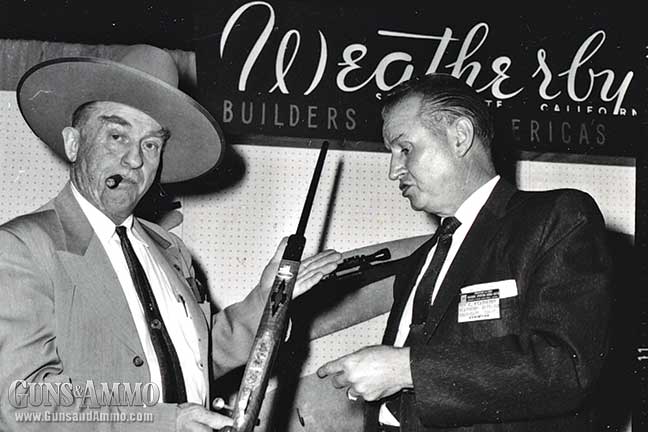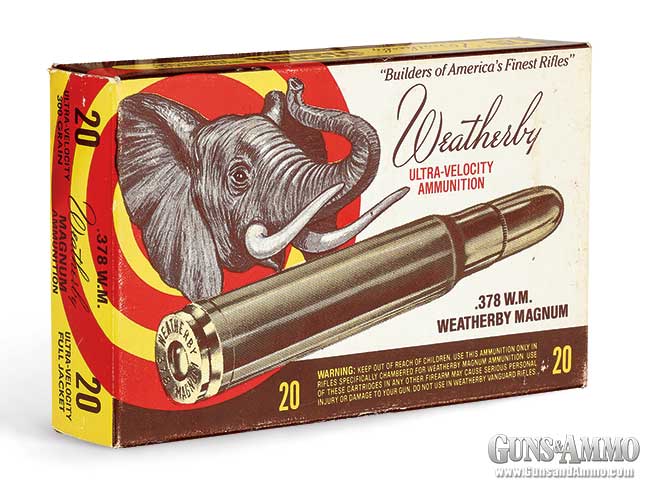A Short History of Weatherby- Craig Boddington
Posted: Thu May 26, 2016 6:25 pm
http://www.gunsandammo.com/historical/a ... weatherby/

Elmer Keith (left) and Roy Weatherby


Elmer Keith (left) and Roy Weatherby

The year was 1945, and the country was euphoric over its victory in World War II, first in Europe, then in the Pacific. A brash young man from Kansas, Roy E. Weatherby started the firearms company that, 71 years later, still bears his name and continues to be managed by his descendants. Born September 4, 1910, and living until April 4, 1988, Roy was a handloader and rifleshooter who pursued the time-honored pastime of wildcatting, creating his own cartridges. Only a small number of his experimental cartridges made the grade when he went commercial, founding his company on his signature line of Weatherby Magnums.
At the outset, the .300 H&H was the parent case, full length for the .300 and .375 Weatherby Magnums, shortened for the .257, .270 and 7mm Weatherby Magnums, taper removed and shouldered in Weatherby’s distinctive double Venturi curve. In years to come, the .340 Weatherby Magnum would be added, also based on the full-length .300 H&H case. Using their own unique cases, Roy would add the .224, .240, .378 and .460 Weatherby Magnums as well. After Roy’s passing, his son, Roy E. Weatherby Jr. — “Ed” — would introduce the .416 Weatherby Magnum and the .30-.378 and .33-.378 Weatherby Magnums.
of-history-weatherby-short-7
Roy Weatherby’s company is marked its 70th anniversary last year by offering 70 classic-stocked Mark V rifles in Roy’s favorite cartridge, the .257 Wby. Mag.
Weatherby rifles were originally based on Mauser actions, with the flagship Mark V action introduced in 1958. In years to come, there would be rimfires, shotguns and the excellent (and amazingly accurate) Vanguard, but at first Weatherby was a rifle company based on the Weatherby Magnum cartridges. “Tomorrow’s Rifles Today” was the slogan, and they really were, at least according to the gospel of Roy Weatherby. He believed in velocity; he bored his rifles with a bit of freebore — an unrifled section ahead of the leade — to give his bullets a head start.
At first, his cartridges were the province of handloaders. Later, when he entered his long (and still-standing) partnership with Norma, his ammo was (and is) loaded to somewhat higher pressures than domestic firms were comfortable with. Some of his cartridges, including the .257 and .270 Weatherby Magnums, remain the fastest in their caliber class. Others, such as the 7mm, .300 and .340, have been slightly surpassed by larger-cased cartridges such as the Remington Ultra Mags (depending on who is doing the loading). Here is the interesting reality: Weatherby’s magnums set a benchmark for velocity and flat trajectory 71 years ago, and to this day only incremental gains have been realized.
history-of-weatherby-short-2
Weatherby’s original packaging was instantly recognizable with bright colors and illustrative art. The .270, 7mm and .340 Wby. Magnums were identifiable by an artistic rendering of a tiger.
Roy Weatherby believed in velocity and his theory of hydrostatic shock that it conveyed. He also wanted his rifles to look different, like “tomorrow’s rifles.” Characteristic and distinctive were his Monte Carlo comb and squared forend with a reverse slant at the tip.
The thing is, Roy Weatherby believed his hype. He lived it and breathed it. He was not just a marketing huckster; he was a true zealot, preaching the gospel of velocity and ultra-modern stock styling. Provided you didn’t bad-mouth his rifles and cartridges, he was also a really nice guy. His son, Ed Weatherby, just said an odd thing to me, that I was “among the last gunwriters who really knew my dad.” Hmm. I didn’t think I was that old, especially since it was only 26 years ago that I attended Roy’s funeral.
weatherby-short-history-of-4
After 10 years of development, the .224 Wby. Magnum was introduced in 1963 as the “Varmintmaster.” Regarded by riflemen as a cartridge best suited for long-range varmint hunting, it never managed to attract popularity.
In retrospect, I was very young when I came into this business, and I will never forget Roy Weatherby’s kindness. In 1978, before I joined then-Petersen Publishing and was very much a struggling young freelancer, Roy Weatherby granted me an interview. It was later revealed that some of his senior people told him he was wasting his time, but it was his time to waste, and he agreed to see me there in his long-standing South Gate, Calif., office.
That was actually the second time I met him, but I doubt he remembered the first. When I was about 12 years old, Roy came to speak at a meeting with the Kansas Rifle and Pistol Association. My uncle, who knew him, picked up Roy in Kansas City, and I rode along on the trip to Topeka. Gun-struck kid that I was, I pestered him with questions all the way there, and he answered them patiently. Roy Weatherby always had time for young shooters.
short-weatherby-history-of-5
This brown bear was taken on the Kamchatka Peninsula in Russia’s Far East with a Weatherby Mark V in .340 Weatherby Magnum, always a fine choice for places where bears can get really big.
Which brings me to my favorite memory. It was during the 1984 Olympics, held in Los Angeles, with my boss, Robert E. Petersen, as Commissioner of the shooting sports. We (he) decided we should hold a sports fair close to the Olympics venue — in summer in an inland valley — so there we were, in sweltering tents in summer heat. There was Roy Weatherby, long past his first heart attack, just four years from his final one, holding his post in his booth, sweating in jacket and tie and holding forth to enthralled youngsters (and many oldsters) on his beliefs. I was there in shirtsleeves, a long way shy of 40, and I was miserable. Roy preached his gospel of velocity, accuracy and performance to a whole new audience. Through those long, hot afternoons, he gave us all strength.
Time goes on, people must go, and other people must step in. Roy E. Weatherby Jr. — “Ed” — is at the helm now. He assumed the reigns of the company upon his father’s death in 1988. There will never be another Roy E. Weatherby, but this I can say about his son: Some apples don’t fall far from the tree. Ed Weatherby is the finest natural rifle shot I have ever known.
of-weatherby-short-history-3
Developed in 1968, the .240 Wby. Magnum was the last cartridge designed by Roy Weatherby. Identified by a whitetail on its box, it was once the fastest commercially produced 6mm, pushing a 100-grain bullet out a 26-inch barrel at 3,400 fps.
Last year, I asked Ed what the 70th anniversary of his company meant to him, and he replied: “In the early years, his slogan was ‘Tomorrow’s Rifles Today.’ Truly, they were tomorrow’s rifles. As it was then and still is today, nothing shoots flatter, hits harder or is more accurate than a Weatherby. He started and built Weatherby with innovation, performance and quality. These three factors still drive Weatherby today.”
Ed Weatherby’s son, Adam Weatherby, third generation, was away from the firm for some years before he came back to assume the role of executive vice president and COO. “One of the phrases we have often heard throughout the last 71 years is, ‘I’ve always wanted to own a Weatherby.’ Weatherby has inspired the dreams of hunters and shooters. It is for this reason that we exist,” he said.
history-of-short-weatherby-6
Designed by Roy Weatherby in 1953 as an original belted magnum with no parent case, the .378 Wby. Magnum was used by Roy to kill an African elephant with one shot. By 1958, he necked up the .378 to .458 caliber, calling it the .460 Wby. Mag.
I don’t know Adam Weatherby very well, but I need to know him better. I think he will remind me very much of his grandfather, and that is a wonderful thing.